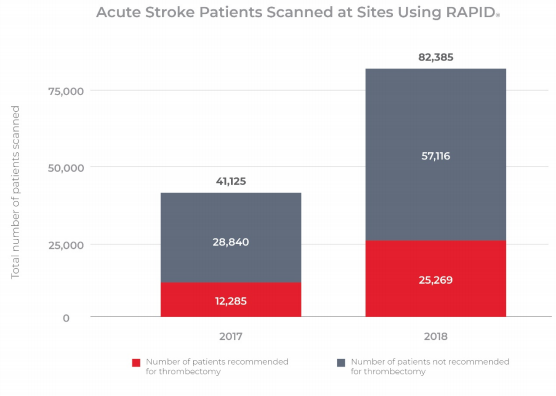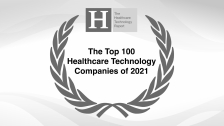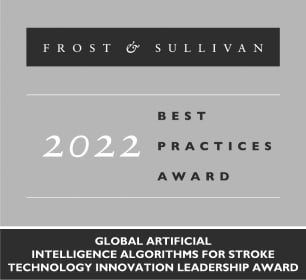Menlo Park, Calif. —May 15, 2019 – May is Stroke Awareness Month and in commemoration, iSchemaView, the worldwide leader in advanced imaging for stroke, is releasing its first market intelligence data from RAPID. The RAPID platform is designed to provide physicians with fast, fully automated, and easy-to-interpret imaging that facilitates clinical decision-making around stroke. Stroke afflicts around 800,000 Americans each year and ranks as the number five cause of death and the number one cause of disability in the United States. New RAPID data reveals that over 40,000 more patients’ lives were impacted in 2018 over 2017 via this advanced technology, more than doubling the number of patients scanned and thrombectomies indicated by imaging.
iSchemaView’s RAPID has changed how physicians approach stroke care. From 2017 to 2018 there was over a 100% increase in patients imaged with RAPID worldwide (41,125 in 2017 and 82,365 in 2018). Perfusion imaging criteria was met for thrombectomy in 12,285 patients in 2017 and 25,269 in 2018. Based on the first quarter of 2019, RAPID is on pace to image over 132,500 patients in 2019 and identify over 40,000 potential patients for thrombectomies. The platform is also estimated to process over 250,000 total scans this year.

While the above represents dramatic overall growth in patients addressed and thrombectomies indicated around the world, there was also significant same-site growth. Looking only at care sites active with the RAPID platform in 2017 as compared to the same sites in 2018, there was over a 50% growth in patients addressed (39,955 in 2017 and 60,821 in 2018), and potential thrombectomies indicated (11,811 in 2017 and 17,742 in 2018).
This dramatic expansion in patients scanned tracks with new 2018 American Heart Association and American Stroke Association guidelines that have dramatically altered the management of acute stroke. These new guidelines were established after a series of studies were conducted and published by iSchemaView co-founder, Dr. Greg Albers and others.
“RAPID has greatly impacted our ability to offer life- and disability-saving care to our patients,” said Cherylee Chang, M.D., medical director, Neuroscience Institute/Neurocritical Care at The Queen's Medical Center. “In 2017 we performed 37 thrombectomies; this increased to 93 in 2018 and we have already exceeded 30 cases in the first 3 months of 2019. Due to the ability of our stroke team, which includes our neurointerventionalists, to receive immediate results of RAPID’s perfusion imaging, our median door-to-puncture time is 46 minutes. RAPID has revolutionized stroke care.”
“It is now just over a year since the simultaneous publication of DEFUSE 3 and the new 24-hour stroke treatment guidelines. Taking a look at the latest treatment numbers, it seems clear that the imaging-based studies have already made a huge impact on stroke care worldwide,” said Dr. Greg Albers, professor of neurology at Stanford University, director of the Stanford Stroke Center and co-founder of iSchemaView. “By building on the artificial intelligence and advanced imaging technology in RAPID, we will continue to contribute to increased treatment rates which will lead to a major reduction in stroke disability and mortality.”
Peter Evers
Natron Communications
(415) 524-8899
peter@natroncomm.com


